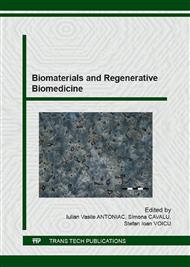[1]
J.L. Gutmann, T.R. Pitt Ford, Management of the resected root end: a clinical review, Int Endod J 233 (1993) 273-283.
Google Scholar
[2]
M.L. Zuolo, M.O.F. Ferreira, J.L. Gutmann, Prognosis in periradicular surgery: a clinical prospective study, Int Endod J 33 (2000) 91-98.
DOI: 10.1046/j.1365-2591.2000.00263.x
Google Scholar
[3]
R.D. Kraus, T. von Arx, D. Gfeller, J. Ducommun, S.J. Jensen, Assessment of the nonoperated root after apical surgery of the other root in mandibular molars: a 5-year follow-up study, J Endod 41 (2015) 442-446.
DOI: 10.1016/j.joen.2014.11.024
Google Scholar
[4]
J. Mente, M. Leo, A. Michel, H. Gehrig, D. Saure, T. Pfefferle, Outcome of orthograde retreatment after failed apicoectomy: use of mineral trioxide aggregate apical plug, J Endod 41 (2015) 613-620.
DOI: 10.1016/j.joen.2015.01.002
Google Scholar
[5]
R.A. Rubinstein, S. Kim, Long-term follow-up of cases considered healed one year after apical microsurgery, J Endod 28 (2002) 378-383.
DOI: 10.1097/00004770-200205000-00008
Google Scholar
[6]
M. Maddalone, M. Gagliani, Periapical endodontic surgery: a 3-year follow-up study, Int Endod J 36 (2003) 193-198.
DOI: 10.1046/j.1365-2591.2003.00642.x
Google Scholar
[7]
S. Kim, S. Kratchman, Modern endodontic surgery concepts and practice: a review, J Endod 32 (2006) 401-623.
Google Scholar
[8]
P.Z. Tawil, V.M. Saraiya, J.C. Galicia, D.J. Duggan, Periapical microsurgery: the effect of root dentinal defects on short- and long-term outcome, J Endod 41 (2015) 22-27.
DOI: 10.1016/j.joen.2014.08.007
Google Scholar
[9]
B.S. Chong, T.R. Pitt Ford, Root-end filling materials: rationale and tissue response, Endod Topics 11 (2005) 114-130.
DOI: 10.1111/j.1601-1546.2005.00164.x
Google Scholar
[10]
J.E. Dahl, Toxicity of endodontic filling materials, Endod Topics 12 (2005) 39-43.
Google Scholar
[11]
R.A. Meshack, K. Velkrishna, P.V.K. Chakravarthy, J. Nerali, Overview of root end filling materials, Int J Clin Dent Science 3 (2012) 63-69.
Google Scholar
[12]
J.N. Theodosopoulou, R. Niederman, A systematic review of in vitro retrograde obturation materials, J Endod 31 (2005) 341-349.
DOI: 10.1097/01.don.0000145034.10218.3f
Google Scholar
[13]
M. Trope, A. Bunes, G. Debelian, Root filling materials and techniques: bioceramics a new hope?, Endod Topics, 32 (2015) 86-96.
DOI: 10.1111/etp.12074
Google Scholar
[14]
D.C. Bird, T. Komabayashi, L. Guo, L.A. Opperman, R. Spears, In vitro evaluation of dentinal tubule penetration and biomineralization ability of a new root-end filing material, J Endod 38 (2012) 1093-1096.
DOI: 10.1016/j.joen.2012.04.017
Google Scholar
[15]
F.G. Aguilar, L.F.R. Garcia, F.C.P. Pires-de-Souza, Biocompatibility of new calcium aluminate cement (EndoBinder), J Endod 38 (2012) 367-371.
DOI: 10.1016/j.joen.2011.11.002
Google Scholar
[16]
B.A. Damas, M.A. Wheater, J.S. Bringas, M.M. Hoen, Cytotoxicity comparison of mineral trioxide aggregates and EndoSequence bioceramic root repair materials, J Endod 37 (2011) 372-375.
DOI: 10.1016/j.joen.2010.11.027
Google Scholar
[17]
W.A. Khalil, S.K. Abunasef, Can mineral trioxide aggregate and nanoparticulate EndoSequence Root Repair Material produce injurious effects to rat subcutaneous tissues?, J Endod 41 (2015) 1151-1156.
DOI: 10.1016/j.joen.2015.02.034
Google Scholar
[18]
R.L. Steinbrunner, C.E. Brown, J.J. Legan, A.H. Kafrawy, Biocompatibility of two apatite cements, J Endod 24 (1998) 335-342.
DOI: 10.1016/s0099-2399(98)80130-1
Google Scholar
[19]
C.C. Bosio, G.S. Felippe, E.A. Bortoluzzi, M.C.S. Felippe, W.T. Felippe, E.R.C. Rivero, Subcutaneous connective tissue reactions to iRoot SP, mineral trioxide aggregate (MTA) Fillapex, DiaRoot BioAggregate and MTA, Int Endod J 47 (2014) 667-674.
DOI: 10.1111/iej.12203
Google Scholar


